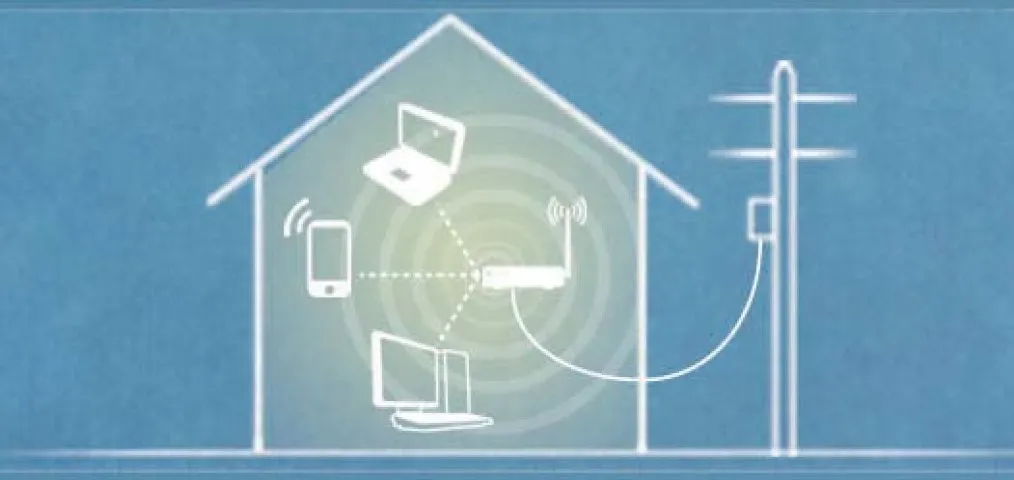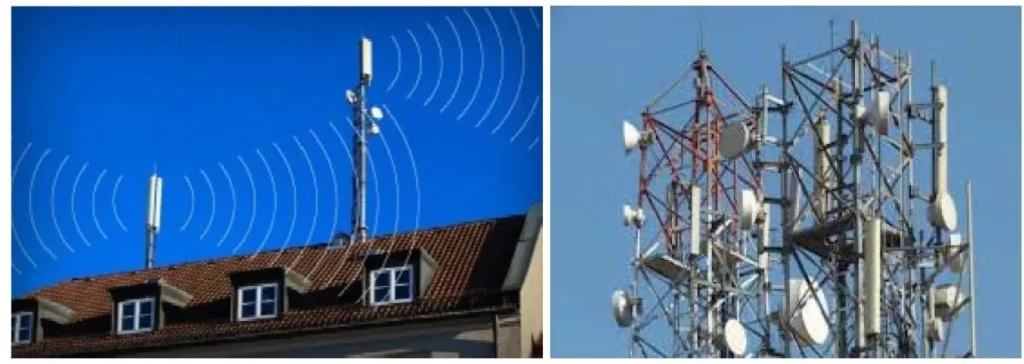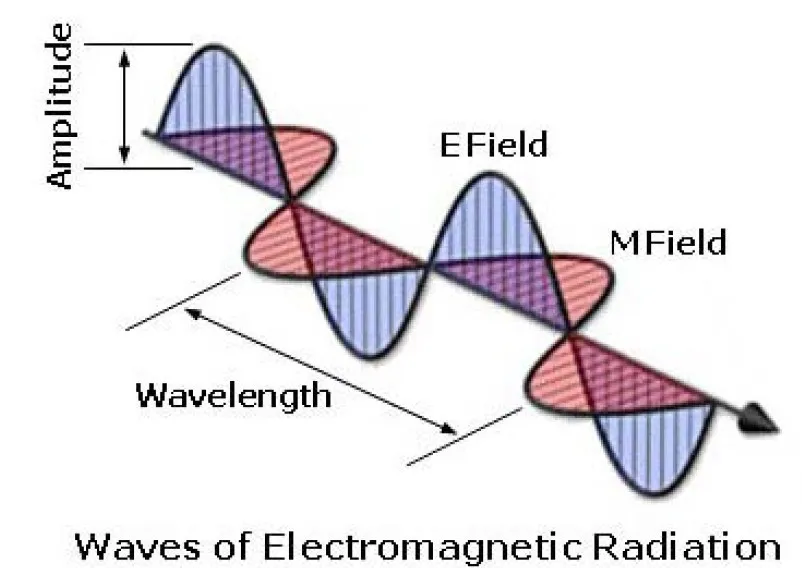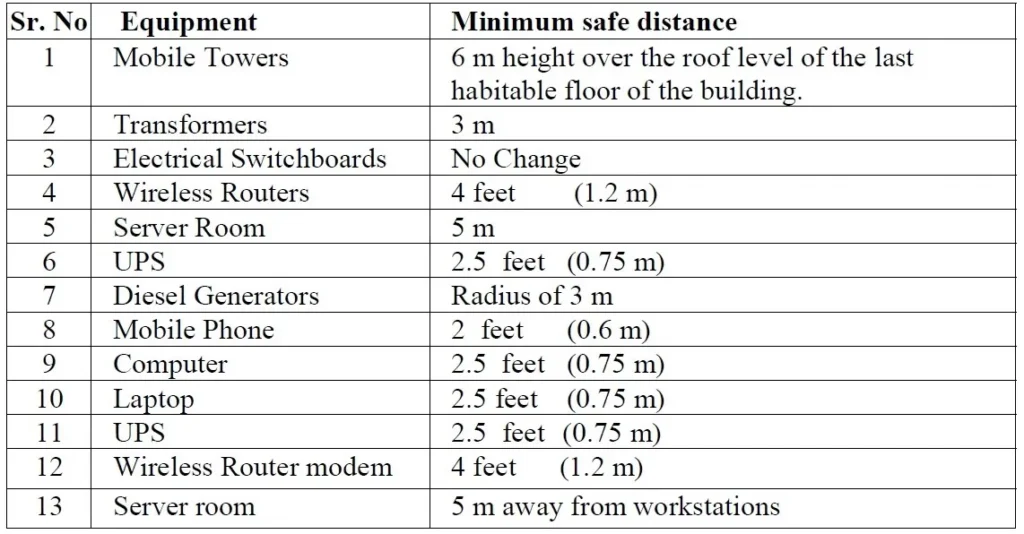If you want to know about electrical distribution system or layout of substation in a building or staircase design, please click the link.
The placement of electrical equipment in a building is an important aspect of electrical design and safety. It involves the careful consideration of several factors such as accessibility, safety, maintenance, and electrical codes.
- Electromagnetic radiations are energy waves having time varying electric and magnetic fields at right angles to each other and are predominantly used for wireless communication.

Electro Magnetic fields can be broadly divided into:
- Low-frequency electromagnetic fields- the common sources of which include power lines, household electrical appliances, and
- High frequency electromagnetic fields- the main sources of which are radar, radio and television broadcasting, mobile telephones and their base stations, induction heaters and anti-theft devices etc.
1) Electromagnetic radiations
i) Effects of exposure
- The effects of electromagnetic radiation upon living cells, including those on humans, depend upon the frequency as well as the penetrating power of the radiation.
- Health risks from Electromagnetic radiations can be numerous depending upon the power and frequency of radiations.
- From the perspective of prevention of any health effects of Electro Magnetic Radiations there is a need of suitable precautions, since it is not possible to keep away from them owing to the advent of wireless communication technology which is based upon electromagnetic waves of higher frequencies besides many other applications like microwave, remote controlled toys, cordless phones, TV remotes etc.
2) Guidelines for Buildings and Built forms mitigating effects of EMR
- While planning a building or a residential complex/ township, it is most desirable to list all probable equipments/ appliance emitting Electromagnetic Radiations in order of ascending/descending intensities.
- These should also be categorized as per indoor and outdoor emissions.
- Their placement in the built space and surroundings can then be decided based on certain premises.
- The most fundamental principal in this regard is that the effect of Electromagnetic Radiation decreases with increase in distance from radiation emitting source. It is thus advisable.
- To keep a safe distance from working electric and electronic equipment’s.
- Minimize the use of all equipment’s working on wireless technology like cordless phones, Wi-Fi, Bluetooth and the cell phones.
- Disconnect electric and electronic equipment’s from the power supply when not in use, especially in areas of prolonged occupancy.
Further, the list of equipment’s/appliances generally used in, and around working/living space is placed below for appreciation of EMR radiations:
- RF Sources i.e., the transmitting towers such as AM/FM radio towers, TV towers, cell phone towers transmitting EMR continuously.
- Cell phone which is ON but not in use also radiates and Wi Fi (Wireless Internet)
- Cordless phone
- Wi-max
- Other wireless devices
- CFL (Compact Florescent Light) bulbs
- Neighboring EMR sources that are located next to shared walls.
- Computers and laptops
- Air conditioning systems
- Refrigerators
- Electrical heating systems/ Microwave Ovens
- Power generators and voltage converters
- Stereo and home entertainment systems Fans
This list is only indicative and not exhaustive and there can be additions to it.
- From the viewpoint of effective communication, providing of mobile towers in a township / office complex is an essential requirement and thus should be carefully planned.
- The mobile tower generates and transmits high frequency radiations; so more care is needed for their placement.
- It should be ensured that the building identified to mount the
- tower should be the tallest in the vicinity and should not have adjoining buildings on which proposed or existing habitable floors are within close range.
OR
- Mobile Tower should be mounted on the highest sanctioned building in an area.
- In regular practice that many cellular operators mount their antenna on a single tower along with other operators which increase the effects of EMR manifolds and should thus be avoided as far as possible. Else height of the tower should be increased.
- Besides, Substation Equipment’s like Transformer, DG set etc. are also to be provided for fulfilling the bulk power requirement of the building and should be suitably placed for electrical safety as well as for mitigating effects of EMR.
- However, as these are low frequency devices, their placement is too decided more from electrical safety point of view than EMR. In addition, various light sources inside the living/working spaces, UPS, servers, various other equipment’s running on Wi-Fi may also emit EMR. Hence their placement inside the building also needs careful consideration.
- Thus, in a built environment of considerable human occupancy, following broad guidelines should be adopted for placement of utility equipment’s/ appliances serving the building as a whole:
3) Equipment’s external to the building
i) Mobile towers

- Location of communication towers is governed by radio frequency system adopted and as far as possible cellular operator should try to avoid residential areas. However, where it is not possible to avoid these, they should request for permission from the appropriate authority for installation on roof top of the tallest existing buildings.
- First preference should, however, be given to the location of tower in the commercial areas of other public areas.
- Where it is not possible to avoid the location of this tower in residential, area possibility should be explored to locate them in green belts within residential sectors or open spaces/community building in the sectors.
- Where it is not possible to find such suitable space mentioned at Above, tower should be permitted on the roof top of residential building subject to the condition that a structural safety certificate from a certified Structure Engineer has been obtained.
- Such towers should not be permitted on occupied buildings, however if inevitable, a Steel/Metal frame of 6 M height over the roof level of the last habitable floor of the building should be provided to accommodate the tower and its associated units.
- Structure stability of the said building should be calculated with the overall loading of such metal/steel frames mounted atop and ‘Structural stability certificate’ should be submitted by a registered structural engineer with the application for permission of building (pre-design) or installation (post-design)
ii) Transformers
- In addition to the fenced ionized area around a transformer, neighborhood level congregation activity areas should not be planned/permitted within 3 M of the fence.
iii) Diesel Generators
- The location of the Generator within the Plot premises should not be adjacent to any habitable / community / recreational activity within a radius of 3M.
4) Indoor Equipment’s/Appliances
i) Electrical Switchboards
- Unless otherwise amended by Barrier-free access regulations to such fixtures, they should be mounted as per existing stipulations laid down in CPWD General Specifications for Electrical Works- Part I Internal 2013.
ii) Wireless Routers
- Within the housing unit, the vertical mounting height of the router should be not less than 4 feet and should be kept in the Drawing / Dining zone and not within the zones of longer period of occupancy e.g., Bedrooms.
- In non – residential units i.e., office spaces these routers should be kept as much away as possible and should be switched off when not in use.

iii) Server Room
- Occupied Work-station’s should be at least 5 meters away from the server room or associated equipment’s.
- If people are sitting in the same room, they must wear protective gear and should not have prolonged exposure.
iv) Computer
- Should be placed in the most isolated place in a dwelling unit, while in an office space, it should not be less than 2.5 feet away from the person using it.
v) UPS
- Should also be placed in the most isolated place in a dwelling unit, while in an office space it should not be less than 2.5 feet away from the person using it.
vi) Mobile Phone
- It usually remains with the user all the time. The only time it is kept away is when it is being charged.
- Thus, mobile should be charged from a remotely located power point.
- It is thus preferable to provide a charging station in almost every working/living space at a location, as far as permissible from living space considerations.
vii) Light sources
- Usually, sun as a source of natural light is the biggest source of electromagnetic radiations. However, the atmosphere surrounding us provides a natural shield from electromagnetic radiations.
- In this context, the light sources used inside a living/working space should be given careful consideration from the point of view of Electromagnetic Radiations.
- Many luminaries available presently, like fluorescent tubes, compact fluorescent lamps, LED lights etc. are used in working / living spaces.
- So, their use should not only be determined from the point of view of energy conservation but also from the point of view of Electromagnetic Radiations. For this purpose, recommendations of the manufacturers should serve as proper guidelines.
Table below summarizes appropriate placement of equipment’s/appliances in the built environment:

By considering these guidelines, the placement of electrical equipment in a building can be determined in a safe and effective manner.